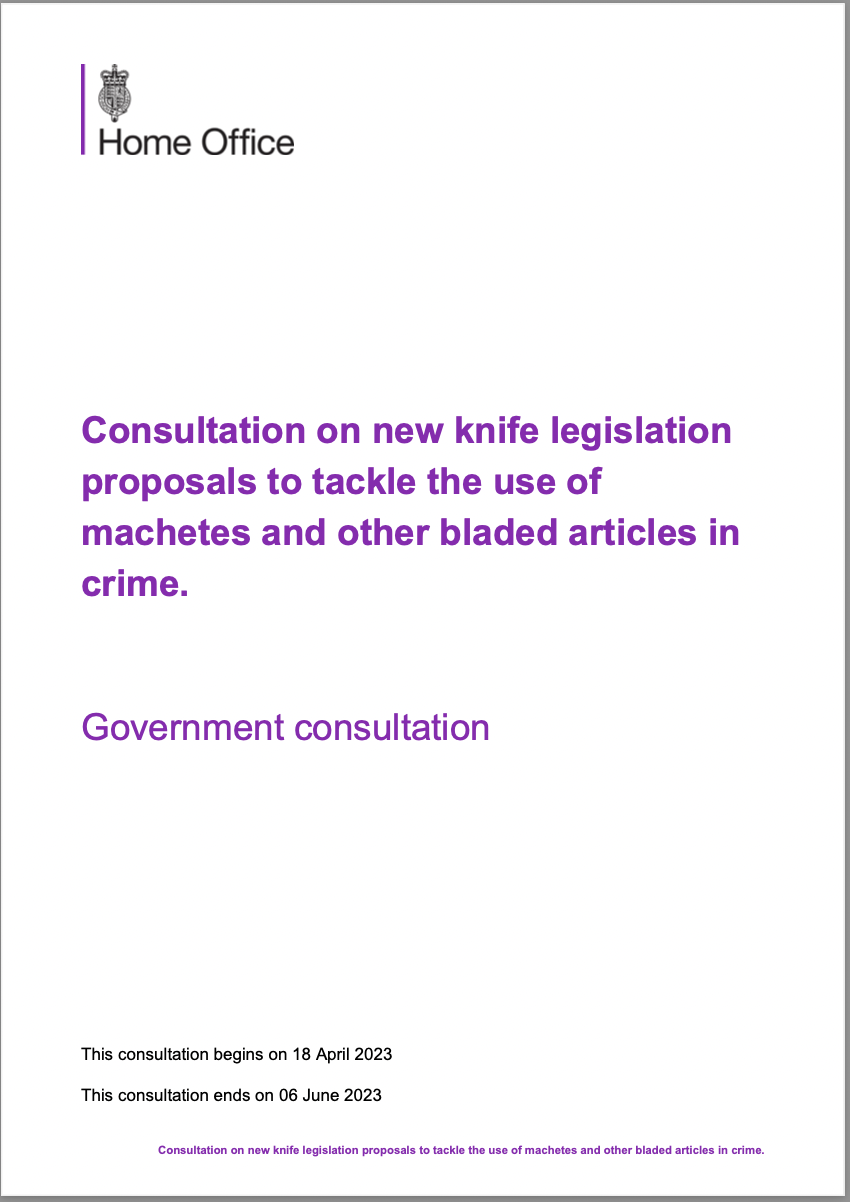
This consultation begins on 18 April 2023 and ends on 06 June 2023. Please consider making a response.
The government is taking action at every level to cut crime and make our streets safer, but we know there is more to do to protect the public and end the scourge of serious violence.
Of all recorded homicides in the year ending September 2022, the proportion where a knife or sharp instrument was the method of killing was 39%. Thousands of people are seeking hospital treatment for stab wounds each year, with some offences never reported to police.
We are consulting on legislative measures to provide the police with more tools to disrupt knife possession and tackle knife crime. We have identified certain types of machetes and large outdoor knives that do not seem to have a practical use and appear to be designed to look menacing and be favoured by those who want to use these knives as weapons. We intend to include them in the list of prohibited offensive weapons set out in the schedule to The Criminal Justice Act 1988 (Offensive Weapons) Order 1988. Weapons listed in this schedule are prohibited under s141 of the Criminal Justice Act 1988. This would mean that the manufacture, importation, sale and supply of these items would be an offence. Possession, both in public and in private, would also be an offence, unless a defence applies. We are inviting views from respondents on the finer details of the description of the items we intend to ban.
We are also consulting on whether to provide the police with additional powers to enable them to seize, retain and destroy bladed articles of any length held in private, or whether the powers should be limited to articles of a certain length, even if the items themselves are not prohibited. We consider it a proportionate response for the police, where they are in private property lawfully, to seize, retain and eventually destroy bladed articles if they have good reason to believe they will be used in crime. We would like to test this proposal with stakeholders and other members of the public so that we ensure that the most effective but proportionate system is put in place.
In addition, we are consulting on whether there is a need for the Government to toughen the current penalties for selling prohibited offensive weapons and selling bladed articles to persons under 18, and on whether the Criminal Justice System should treat carrying prohibited knives and offensive weapons in public more seriously to better reflect the severity of the offences.
Finally, we are consulting on whether it would be appropriate to mirror firearms legislation and introduce a separate possession offence of knives and offensive weapons with intent to injure or cause fear of violence. This would carry a maximum penalty higher than the current offence of possession of an offensive weapon in public under s1 of the Prevention of Crime Act 1953 (the PCA).
The responses to this 8-week consultation will inform our proposals on whether there is a need for future legislation and, if so, the form that this will take.
The measures in this consultation are proposals at this stage and remain subject to change following the consultation process. Any legislative proposals considered necessary would apply in relation to England and Wales only. While we have already engaged with operational partners, the consultation is open to the public and seeks the views of directly affected parties, businesses and organisations with a direct interest in the proposals, and key stakeholder groups and communities affected by the devastating effects of knife crime, to ensure our policy development is informed by a full range of views.
In summary, we are seeking views on the following proposals:
Proposal 1: Introduction of a targeted ban of certain types of large knives that seem to be designed to look menacing with no practical purpose.
Proposal 2: Whether additional powers should be given to the police to seize, retain and destroy lawfully held bladed articles of a certain length if these are found by the police when in private property lawfully and they have reasonable grounds to believe that the article(s) is (are) likely to be used in a criminal act.
Proposal 3: Whether there is a need to increase the maximum penalty for the importation, manufacture, sale and supply of prohibited offensive weapons (s141 of the Criminal Justice Act 1988 and s1 Restriction of Offensive Weapons Act 1959) and the offence of selling bladed articles to persons under 18 (s141A of the Criminal Justice Act 1988) to 2 years, to reflect the severity of these offences.
Proposal 4: Whether the Criminal Justice System should treat possession in public of prohibited knives and offensive weapons more seriously.
Proposal 5: Whether there is a need for a separate possession offence of bladed articles with the intention to injure or cause fear of violence with a maximum penalty higher than the current offence of possession of an offensive weapon under s1 of the PCA 1953.